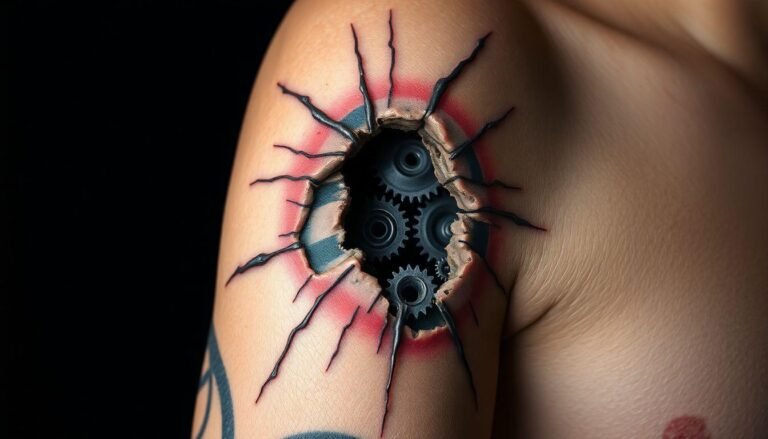Tattoo enthusiasts know that a design concept can make or break the overall impact of their body art. Among the most striking and unique tattoo styles gaining popularity in recent years is the torn skin tattoo design. This optical illusion creates the appearance of skin being ripped open to reveal something underneath—whether it’s mechanical parts, another world, or a meaningful symbol. While these tattoos can be absolutely stunning when executed properly, they may sometimes need touch-ups or adjustments as they age. Let’s explore expert advice on how to either fix or embrace your torn skin tattoo based on professional insights and personal preferences.
What Exactly Is a Torn Skin Tattoo?
A torn skin tattoo creates the illusion that your skin has been ripped open, revealing something hidden underneath. These designs require considerable skill to execute properly because they rely on realistic shading, depth perception, and contrast to create a convincing 3D effect. Common variations include:
The appeal lies in both the shock value and the artistic skill required to create a convincing illusion of depth and realism. A well-executed torn skin tattoo can stop people in their tracks and serve as an impressive conversation starter.
Common Issues With Torn Skin Tattoos
Even the most beautifully executed torn skin tattoos can develop issues over time. Understanding these potential problems can help you decide whether to fix or embrace them as part of your tattoo’s evolution.
Fading Contrast
The 3D illusion depends heavily on sharp contrast between light and shadow. Over time, this contrast may fade, reducing the depth perception effect. Without proper shading, your torn skin effect might lose its realistic appearance and flatten out visually.
Blurring of Fine Details
Many torn skin designs include intricate details that help sell the illusion—like jagged skin edges, tiny shadowing, or detailed elements within the “revealed” area. These fine details are often the first to blur as ink settles and skin ages.
Color Changes
If your torn skin design incorporates color, certain pigments may fade faster than others. This uneven fading can disrupt the visual balance of the design, especially if the colors were chosen specifically to enhance the 3D effect.
Body Changes
Weight fluctuations, muscle gain or loss, and natural aging can all affect how your tattoo sits on your body. Since torn skin designs rely heavily on perspective, these changes can sometimes distort the intended visual effect.
Expert Tips for Fixing Your Torn Skin Tattoo
If you’ve decided your torn skin tattoo needs some professional attention, here’s what experts recommend:
Consult With a Specialist
Not all tattoo artists specialize in 3D or realistic designs. Find an artist who has experience specifically with torn skin concepts and touch-ups. This specialized skill set is crucial for maintaining the illusion.
“I always recommend clients bring photos of the tattoo when it was fresh,” says veteran tattoo artist Mia Chen. “This helps me understand the original vision and where things may have gone astray over time.”
Consider Strategic Touch-Ups
Sometimes, rather than overhauling the entire design, strategic touch-ups can make a world of difference:
Incorporate New Elements
If certain areas have faded beyond repair, consider adding complementary elements that can work with rather than against the aging process.
“I’ve turned faded torn skin tattoos into mixed-media style pieces,” explains tattoo artist Jamal Williams. “We might add elements that appear to be emerging from or interacting with the original design, which can breathe new life into it.”
Embracing and Flaunting Your Aging Torn Skin Tattoo
Not every “imperfection” needs fixing. Many tattoo enthusiasts come to appreciate how their body art evolves over time.
The Wabi-Sabi Perspective
In Japanese aesthetics, wabi-sabi embraces imperfection and transience. Applying this philosophy to your tattoo means appreciating how it changes rather than fighting against that change. The fading and softening can be seen as your body making the art truly yours.
Styling Around Your Tattoo
The way you present your tattoo can enhance its impact, regardless of its condition:
Temporary Enhancement Techniques
For special occasions when you want your tattoo to pop, consider these temporary enhancement methods:
Preventative Care for Torn Skin Tattoos
Whether you’ve fixed your tattoo or decided to embrace it as is, proper care can slow down future deterioration:
When to Consider a Complete Rework
Sometimes, the best decision is to rework the tattoo entirely:
In these cases, consult with an artist who specializes in cover-ups or transformations. Modern techniques and equipment can accomplish remarkable redesigns that build upon rather than completely hide your original torn skin tattoo design.
Conclusion
The journey with your torn skin tattoo doesn’t end after the initial healing process. Like all forms of body art, these designs evolve with you throughout your life. By understanding the common issues that can develop, exploring your options for touch-ups, and learning how to flaunt your design no matter its condition, you can continue to enjoy this unique form of self-expression for years to come. Whether you choose to fix minor issues or embrace the character that comes with aging, your torn skin tattoo remains a personal statement about how you choose to present yourself to the world. Remember, the most important opinion about your tattoo is your own—wear it proudly, however you choose to maintain it.







